Multiscale Resilience in Water Distribution and Drainage Systems
Abstract
1. Introduction
- Reveal the inherent resilience in WDSs and UDSs is monoscale resilience rather than multiscale resilience;
- Provide a practical view of multiscale resilience in WDSs and UDSs;
- Provide methods for building multiscale resilience in both systems;
- Provide verifications based on case studies on a real-world WDS and UDS.
2. Materials and Methods
2.1. Provision of Extra Capacity
2.1.1. Methodology of Provision of Extra Capacity
- Network Decomposition Based on the “Sewer Branch Order”
- Pipe Sizing
- (1)
- Identify the most upstream flooding node: multiple flooding nodes may occur in the same subsystem, and the process should start from the most upstream node (Figure 4).
- (2)
- Select the upstream pipes of the flooding node as candidate pipes for rehabilitation.
- (3)
- Locate the JS node. Here, a JS node refers to a node with the following two principles being satisfied. First, the upstream pipe connected to a JS node had its capacity (Ca = actual depth/max. depth) being equal to 1; second, the downstream pipe connected to that node had a larger size (max. depth) than the upstream pipe. This is to ensure that only pipes without enough capacity are enlarged, and the upstream pipes are always preferable.
- (4)
- Enlarge the upstream pipe of the JS node by one increment based on the used commercial pipe sizes.
- (5)
- Repeat Step (1)–(4) to relocate the most upstream flooding node and the JS node and repeat the process. If no JS node exists (i.e., all candidate pipes have the same size), the most downstream one before the infinite size pipe should be enlarged and next repeat Step (1)–(4).
2.1.2. Case study of Provision of Extra Capacity
2.2. Provision of Extra Connections
3. Results and Discussions
4. Conclusions
- Traditional design of WDSs and UDSs resulted in monoscale resilience, which did not allow flexible water delivery coordination, e.g., smaller scales to support larger scales;
- The proposed method for developing multiscale resilience was to provide extra capacities and/or connections that not only allow water to travel from upstream to downstream (as the traditional design does) but also allow reverse flow in the system during exceptional failure events (i.e., from larger scales to smaller scales in UDS and vice verse in WDS).
- Case studies on a real world UDS and WDS verified: As for the UDS, enlarging smaller upstream pipes provided buffer capacities to accommodate excess water travelling back from downstream pipes due to surcharge and backwater effects. By allowing a temporary storage of storm water for two minutes inside a few pipes, peak flows were attenuated and thus avoided flooding in the system. The multiscale resilient design achieved considerable cost saving (about 10%) and no loss in flood attenuation capacity via the multiscale coordination. For the WDS, using extra connections that can direct flow from the smaller scale to larger scale provided flexibility in water supply coordination (e.g., allowed subsystems at downstream to feed subsystems at upstream) and reduced the total amount of water supply shortage in the system during a failure event of losing the connection to the reservoir.
- Future work includes testing the methods on various real-world WDSs and UDSs, and meanwhile further develop the methodology. Moreover, the methodology will be applied to analyze interdependent systems of systems [45] as an outreach.
Funding
Acknowledgments
Conflicts of Interest
References
- Mehaffy, M.W.; Salingaros, N.A. Design for a Living Planet: Settlement, Science, and the Human Future; Sustasis Foundation: White Salmon, WA, USA, 2015. [Google Scholar]
- Butler, D.; Ward, S.; Sweetapple, C.; Imani, M.; Diao, K.; Farmani, R.; Fu, G. Reliable, resilient and sustainable water management: The Safe & SuRe approach. Glob. Challenges 2016, 1, 63–77. [Google Scholar] [CrossRef]
- Yazdani, A.; Otoo, R.A.; Jeffrey, P. Resilience enhancing expansion strategies for water distribution systems: A network theory approach. Environ. Model. Softw. 2011, 26, 1574–1582. [Google Scholar] [CrossRef]
- Yazdani, A.; Jeffrey, P. Complex network analysis of water distribution systems. Chaos Interdiscip. J. Nonlinear Sci. 2011, 21, 16111. [Google Scholar] [CrossRef] [PubMed]
- Candelieri, A.; Soldi, D.; Archetti, F. Network analysis for resilience evaluation in water distribution networks. Environ. Eng. Manag. J. 2015, 14, 1261–1270. [Google Scholar] [CrossRef]
- Soldi, D.; Candelieri, A.; Archetti, F. Resilience and Vulnerability in Urban Water Distribution Networks through Network Theory and Hydraulic Simulation. Procedia Eng. 2015, 119, 1259–1268. [Google Scholar] [CrossRef]
- Yazdani, A.; Jeffrey, P. Robustness and Vulnerability Analysis of Water Distribution Networks Using Graph Theoretic and Complex Network Principles. Water Distrib. Syst Anal. 2011, 933–945. [Google Scholar] [CrossRef]
- Fernandez, M.H.; Abraham, E.; Stoianov, I.; Fernandez, M.H. A Graph-Theoretic Framework for Assessing the Resilience of Sectorised Water Distribution Networks. Water Resour. Manag. 2016, 30, 1685–1699. [Google Scholar] [CrossRef]
- Diao, K.; Sweetapple, C.; Farmani, R.; Fu, G.; Ward, S.; Butler, D. Global resilience analysis of water distribution systems. Water Res. 2016, 106, 383–393. [Google Scholar] [CrossRef]
- Mugume, S.N.; Gomez, D.E.; Butler, D. Quantifying the Resilience of Urban Drainage Systems Using a Hydraulic Performance Assessment Approach. In Proceedings of the 13th International Conference on Urban Drainage, Sarawak, Malaysia, 7–12 September 2014. [Google Scholar]
- Mugume, S.; Gomez, D.; Fu, G.; Farmani, R.; Butler, D. A global analysis approach for investigating structural resilience in urban drainage systems. Water Res. 2015, 81, 15–26. [Google Scholar] [CrossRef]
- Carlos, M.C.; Toloh, B.; Sanchez-Torres, A.; Vojinović, Z.; Brdjanovic, D. Flood Resilience Assessment in Urban Drainage Systems Through Multi-Objective Optimisation. In Proceedings of the 11th International Conference on Hydroinformatics, New York, NY, USA, 17–21 August 2014. [Google Scholar]
- Walski, T.M.; Barnard, T.E.; Harold, E.; Merritt, L.B.; Walker, N.; Whitman, B.E. Introduction to Wastewater Collection System Modeling. In Wastewater Collection System Modeling and Design, 1st ed.; Barnard, T.E., Dietrich, K., Strafaci, A., Totz, C., Eds.; Haestad Press: Waterbury, CT, USA, 2007; pp. 1–22. [Google Scholar]
- Walski, T.M.; Chase, D.V.; Savic, D.A.; Grayman, W.; Beckwith, S.; Koelle, E. Introduction to Water Distribution Modeling. In Advanced Water Distribution Modeling and Management, 1st ed.; Strafaci, A., Dietrich, K., Totz, C., Eds.; Haestad Press: Waterbury, CT, USA, 2003; pp. 1–18. [Google Scholar]
- World Health Organization (WHO) and Department of International Development (DFID) Summary and Policy Implications? Vision 2030. The Resilience of Water Supply and Sanitation in the Face of Climate Change. Available online: https://www.who.int/water_sanitation_health/vision_2030_9789241598422.pdf?ua=1 (accessed on 16 April 2020).
- UN-Water Climate Change Adaptation: The Pivotal Role of Water. Available online: http://www.unwater.org/downloads/unw_ccpol_web.pdf (accessed on 16 April 2020).
- Ofwat. Resilience–outcomes focused regulation. In Principles for Resilience Planning; The Water Services Regulation Authority for England & Wales: Birmingham, UK, 2012. [Google Scholar]
- Ugarelli, R.; Govindarajan, V.; Brattebo, H.; di Federico, V.; Saegrov, S. Asset Management for Urban Wastewater Pipeline Networks. J. Infrastruct. Syst. 2010, 16, 112–121. [Google Scholar] [CrossRef]
- Hukka, J.J.; Katko, T. Resilient Asset Management and Governance Fordeteriorating Water Services Infrastructure. Proc. Econ. Finance 2015, 21, 112–119. [Google Scholar] [CrossRef]
- Melville-Shreeve, P.; Cotterill, S.; Grant, L.; Arahuetes, A.; Stovin, V.; Farmani, R.; Butler, D. State of SuDS delivery in the United Kingdom. Water Environ. J. 2017, 32, 9–16. [Google Scholar] [CrossRef]
- Jia, H.; Wang, Z.; Zhen, X.; Clar, M.; Yu, S.L. China’s sponge city construction: A discussion on technical approaches. Front. Environ. Sci. Eng. 2017, 11, 18. [Google Scholar] [CrossRef]
- Todini, E. Looped water distribution networks design using a resilience index based heuristic approach. Urban Water 2000, 2, 115–122. [Google Scholar] [CrossRef]
- Ormsbee, L.; Kessler, A. Optimal Upgrading of Hydraulic? Network Reliability. J. Water Resour. Plan. Manag. 1990, 116, 784–802. [Google Scholar] [CrossRef]
- Park, H.; Liebman, J.C. Redundancy-Constrained Minimum-Cost Design of Water-Distribution Nets. J. Water Resour. Plan. Manag. 1993, 119, 83–98. [Google Scholar] [CrossRef]
- Agrawal, M.L.; Gupta, R.; Bhave, P.R. Reliability-Based Strengthening and Expansion of Water Distribution Networks. J. Water Resour. Plan. Manag. 2007, 133, 531–541. [Google Scholar] [CrossRef]
- Ostfeld, A. Optimal reliable design and operation of water distribution systems through decomposition. Water Resour. Res. 2012, 48, 1–14. [Google Scholar] [CrossRef]
- Gupta, R.; Kakwani, N.; Ormsbee, L. Optimal Upgrading of Water Distribution Network Redundancy. J. Water Resour. Plan. Manag. 2015, 141, 04014043. [Google Scholar] [CrossRef]
- Suribabu, C.R. Resilience-based optimal design of water distribution network. Appl. Water Sci. 2017, 7, 4055–4066. [Google Scholar] [CrossRef]
- Mugume, S.; Diao, K.; Imani, M.; Fu, G.; Farmani, R.; Butler, D. Enhancing resilience in urban water systems for future cities. Water Supply 2015, 15, 1343–1352. [Google Scholar] [CrossRef][Green Version]
- Farmani, R.; Walters, G.; Savic, D. Trade-off between Total Cost and Reliability for Anytown Water Distribution Network. J. Water Resour. Plan. Manag. 2005, 131, 161–171. [Google Scholar] [CrossRef]
- Reca, J.; Martinez, J.; Baños, R.; Gil-Montoya, C. Optimal Design of Gravity-Fed Looped Water Distribution Networks Considering the Resilience Index. J. Water Resour. Plan. Manag. 2008, 134, 234–238. [Google Scholar] [CrossRef]
- Wang, Q.; Guidolin, M.; Savic, D.; Kapelan, Z. Two-Objective Design of Benchmark Problems of a Water Distribution System via MOEAs: Towards the Best-Known Approximation of the True Pareto Front. J. Water Resour. Plan. Manag. 2015, 141, 04014060. [Google Scholar] [CrossRef]
- Zhang, C.; Wang, Y.; Li, Y.; Ding, W. Vulnerability Analysis of Urban Drainage Systems: Tree vs. Loop Networks. Sustainability 2017, 9, 397. [Google Scholar] [CrossRef]
- Hesarkazzazi, S.; Hajibabaei, M.; Reyes-Silva, J.D.; Krebs, P.; Sitzenfrei, R. Assessing Redundancy in Stormwater Structures Under Hydraulic Design. Water 2020, 12, 1003. [Google Scholar] [CrossRef]
- Reyes-Silva, J.D.; Helm, B.; Krebs, P. Meshness of sewer networks and its implications for flooding occurrence. Water Sci. Technol. 2020, 81, 40–51. [Google Scholar] [CrossRef]
- Sitzenfrei, R.; Urich, C.; Möderl, M.; Rauch, W. Assessing the efficiency of different CSO positions based on network graph characteristics. Water Sci. Technol. 2013, 67, 1574–1580. [Google Scholar] [CrossRef]
- Urich, C.; Sitzenfrei, R.; Möderl, M.; Rauch, W. An agent-based approach for generating virtual sewer systems. Water Sci. Technol. 2010, 62, 1090–1097. [Google Scholar] [CrossRef]
- Strahler, A.N. Dynamic basis of geomorphology. Geol. Soc. Am. Bull. 1952, 63, 923–938. [Google Scholar] [CrossRef]
- Rossman, L.A. Storm Water Management Model Quality Assurance Report: Dynamic Wave Flow Routing; Water Supply and Water Resources Division National Risk Management Research Laboratory: Cincinnati, OH, USA, 2006.
- Con Cast Pipe Website. Available online: http://www.concastpipe.com/pricing/CC_2012Pricelist.pdf (accessed on 19 March 2012).
- Wong, L.; Nehdi, M.L. Critical Analysis of International Precast Concrete Pipe Standards. Infrastructures 2018, 3, 18. [Google Scholar] [CrossRef]
- Ostfeld, A.; Salomons, E.; Ormsbee, L.; Uber, J.G.; Bros, C.M.; Kalungi, P.; Burd, R.; Zazula-Coetzee, B.; Belrain, T.; Kang, D.; et al. Battle of the Water Calibration Networks (BWCN). Water Distrib. Syst. Anal. 2011, 138, 523–532. [Google Scholar] [CrossRef]
- Wagner, J.M.; Shamir, U.; Marks, D.H. Water Distribution Reliability: Simulation Methods. J. Water Resour. Plan. Manag. 1988, 114, 276–294. [Google Scholar] [CrossRef]
- Diao, K.; Farmani, R.; Fu, G.; Imani, M.; Ward, S.; Butler, D. Clustering analysis of water distribution systems: Identifying critical components and community impacts. Water Sci. Technol. 2014, 70, 1764–1773. [Google Scholar] [CrossRef]
- Ferreira, M.A.M. Networks of Networks: The Last Frontier of Complexity-A Book Review. Int. J. Latest Trends Financ. Econ. Sci. 2014, 4, 708. [Google Scholar]
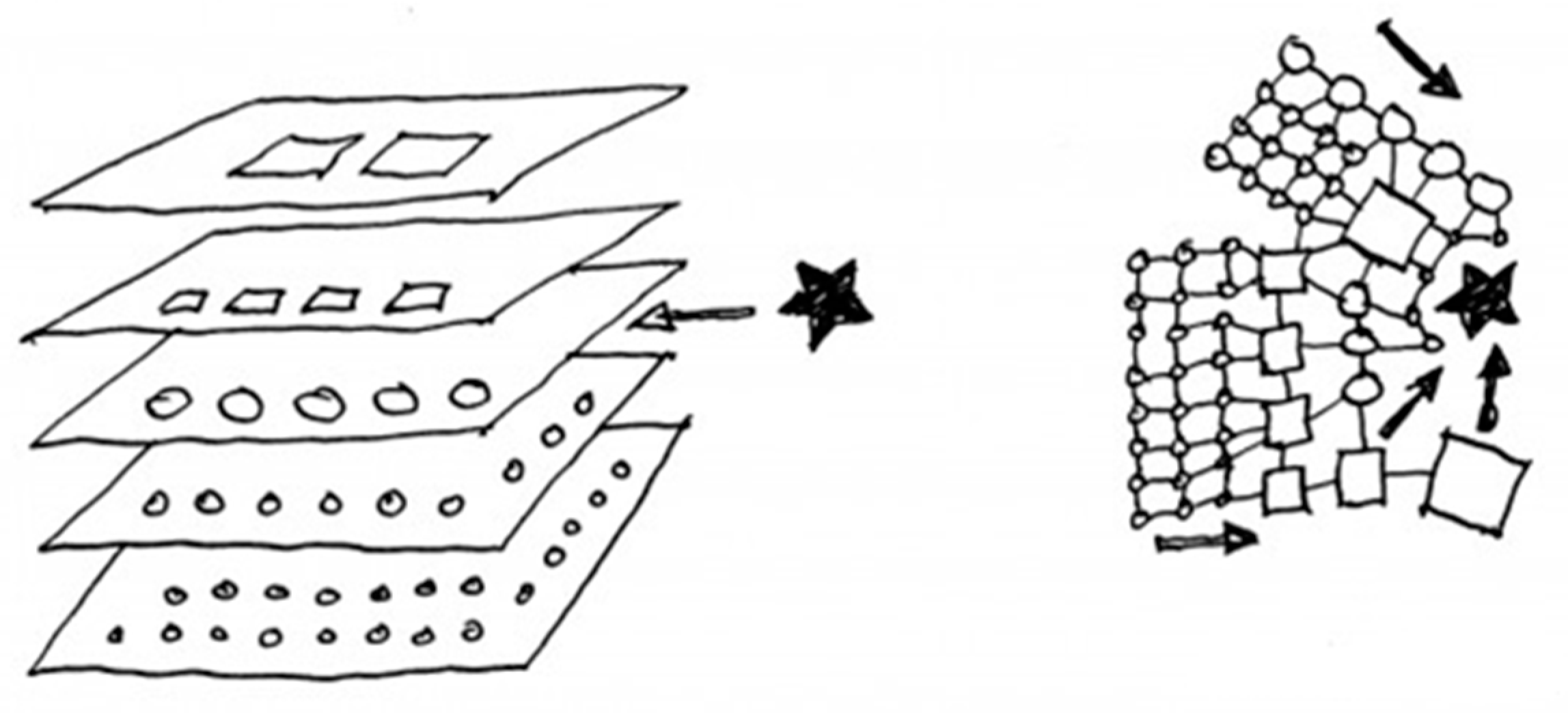
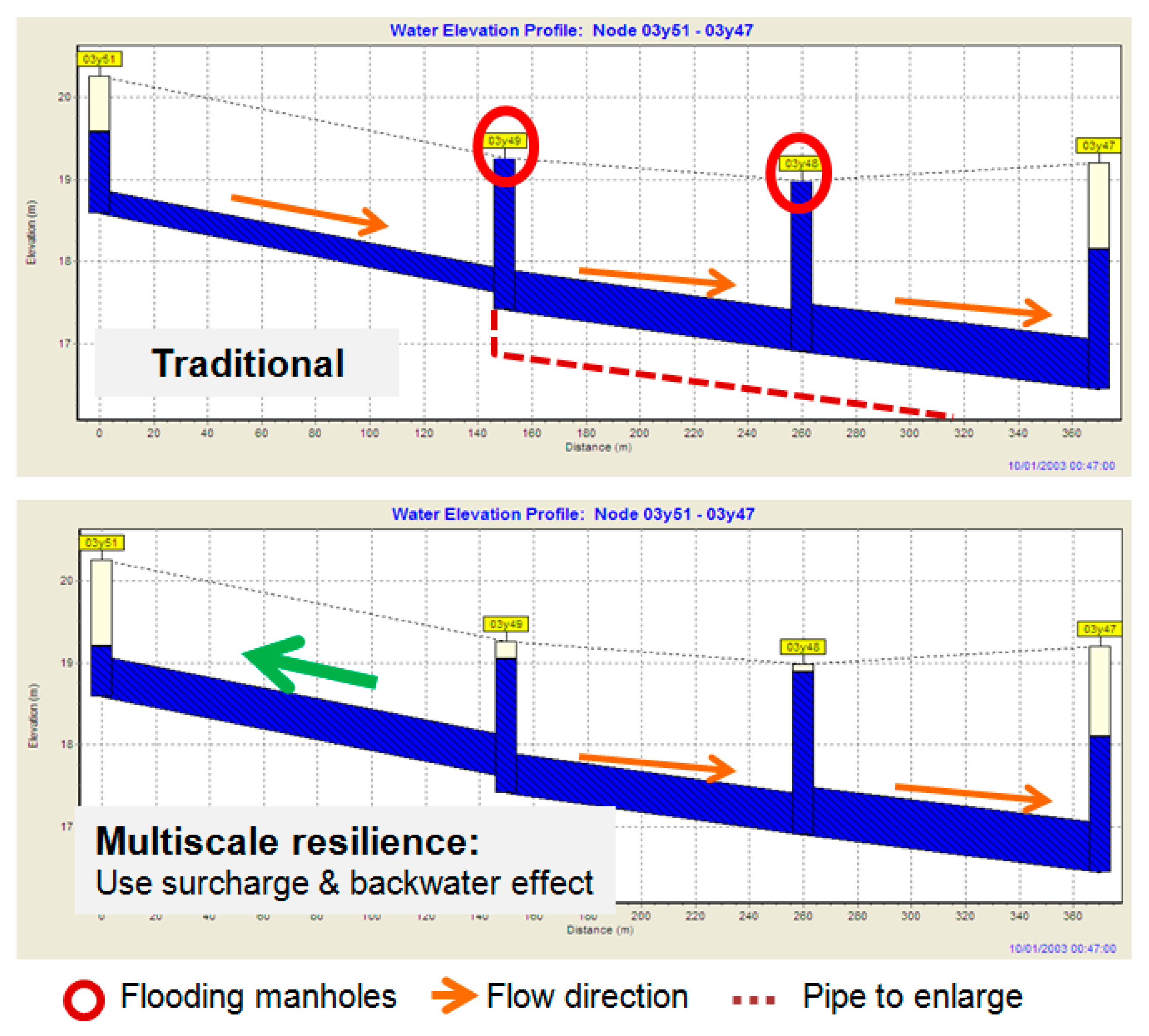
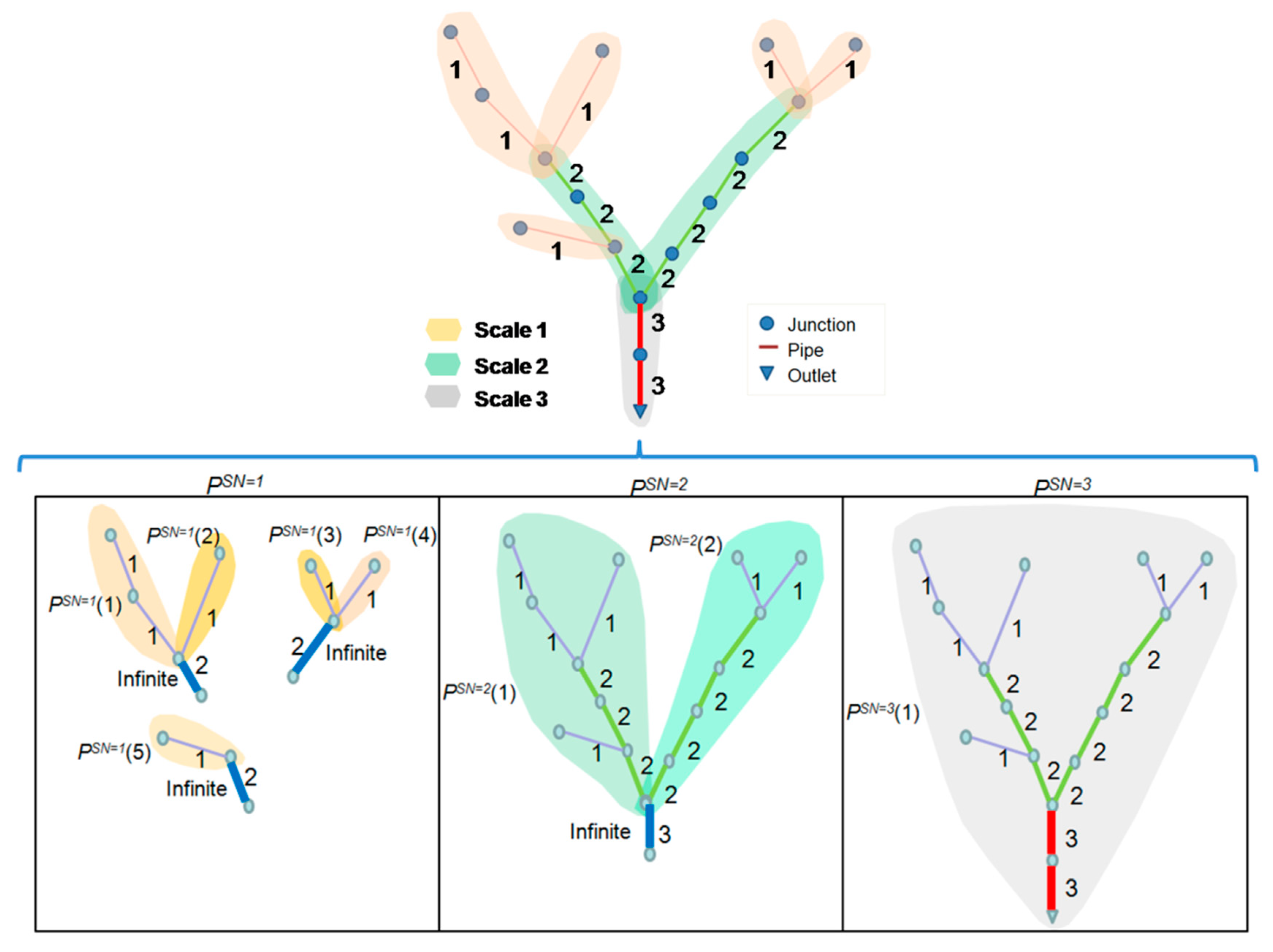
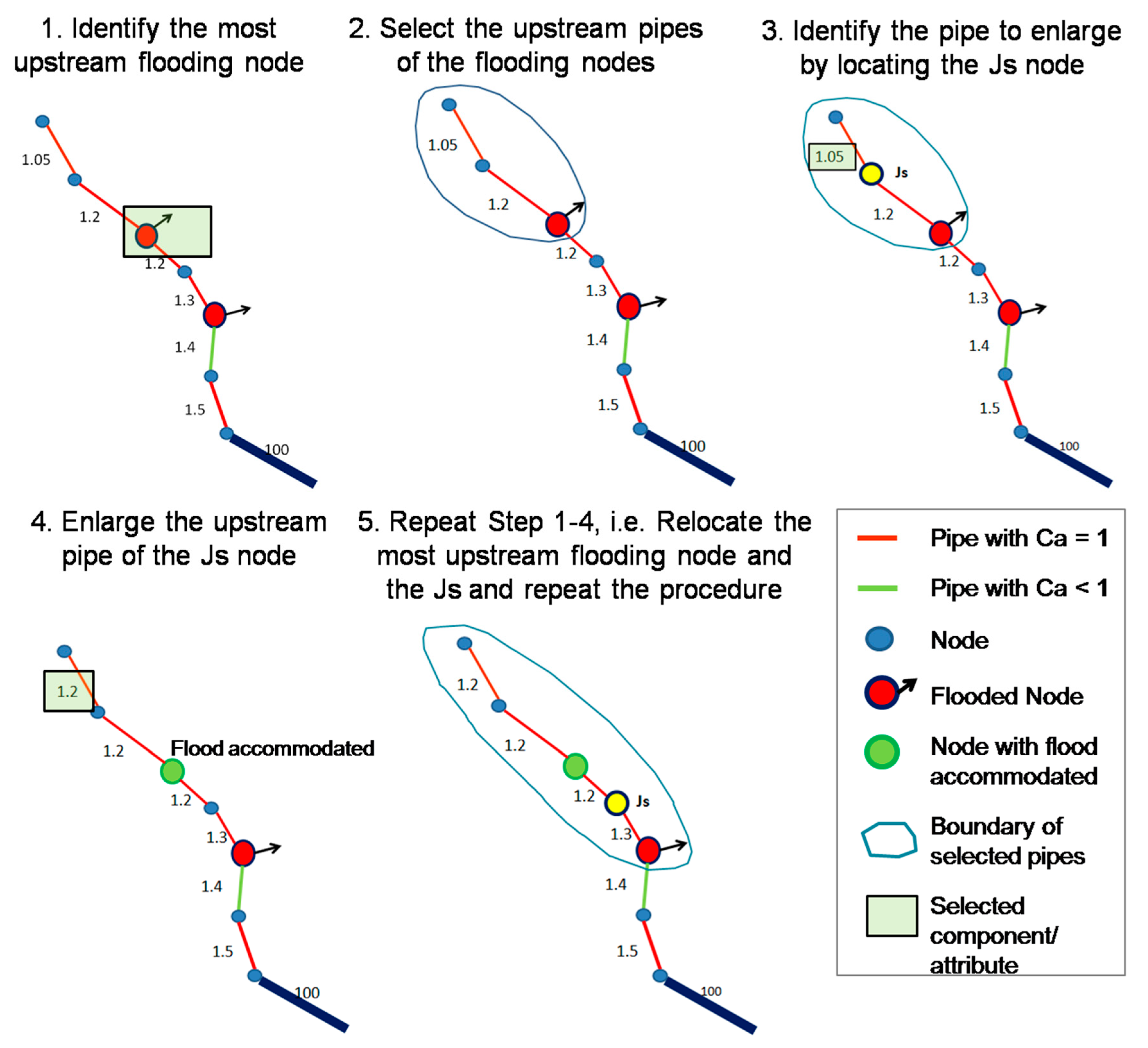
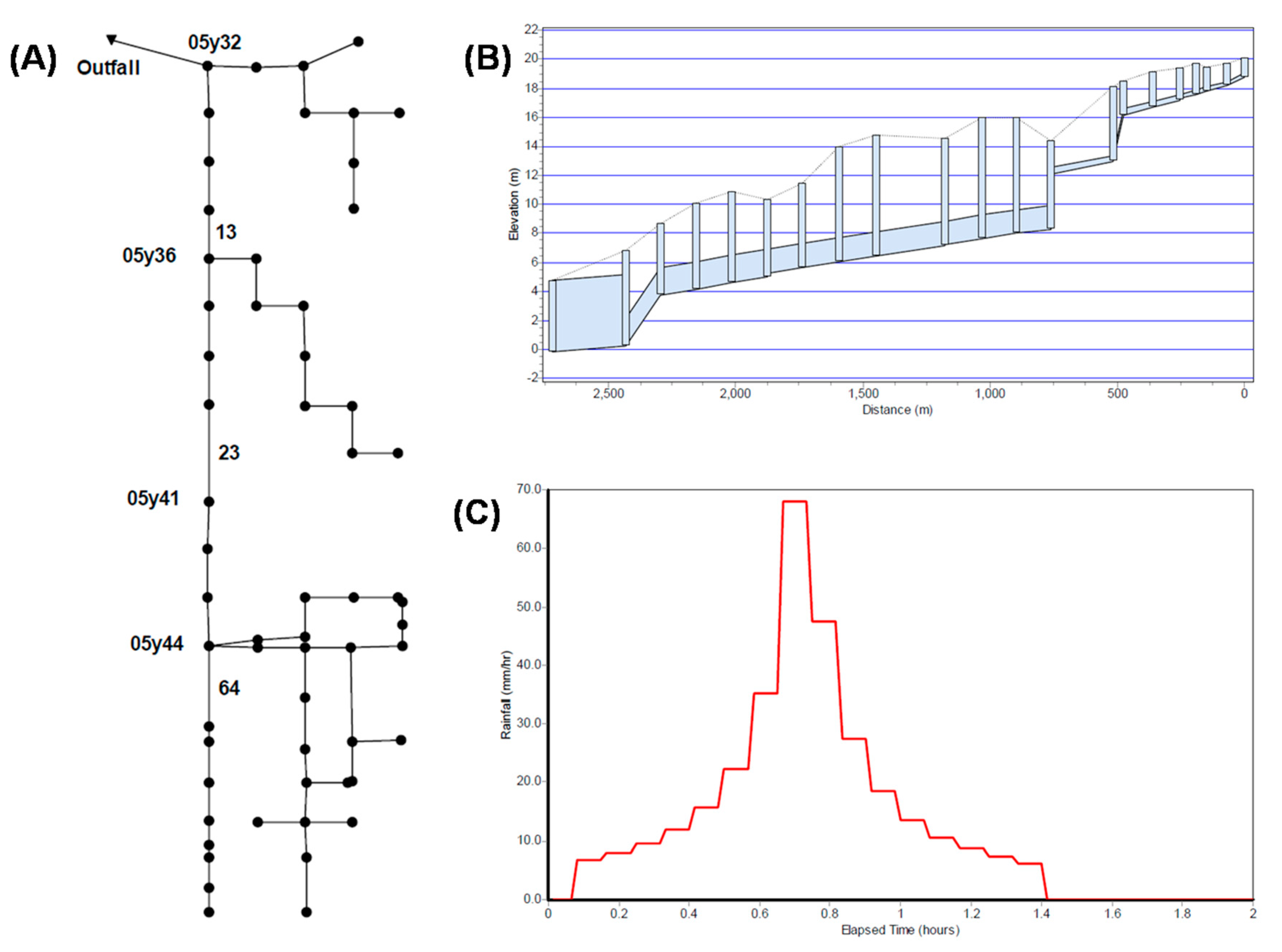
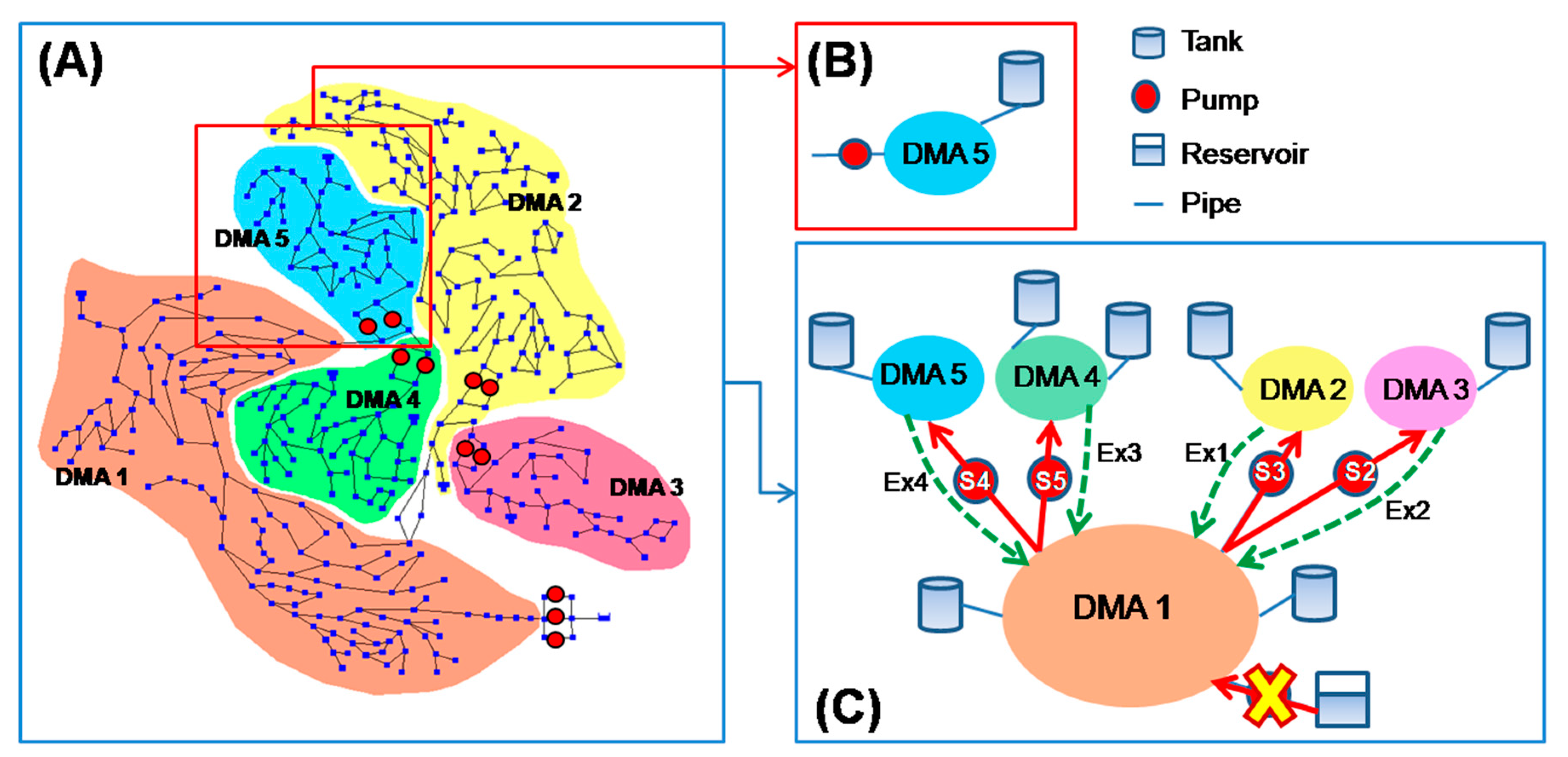
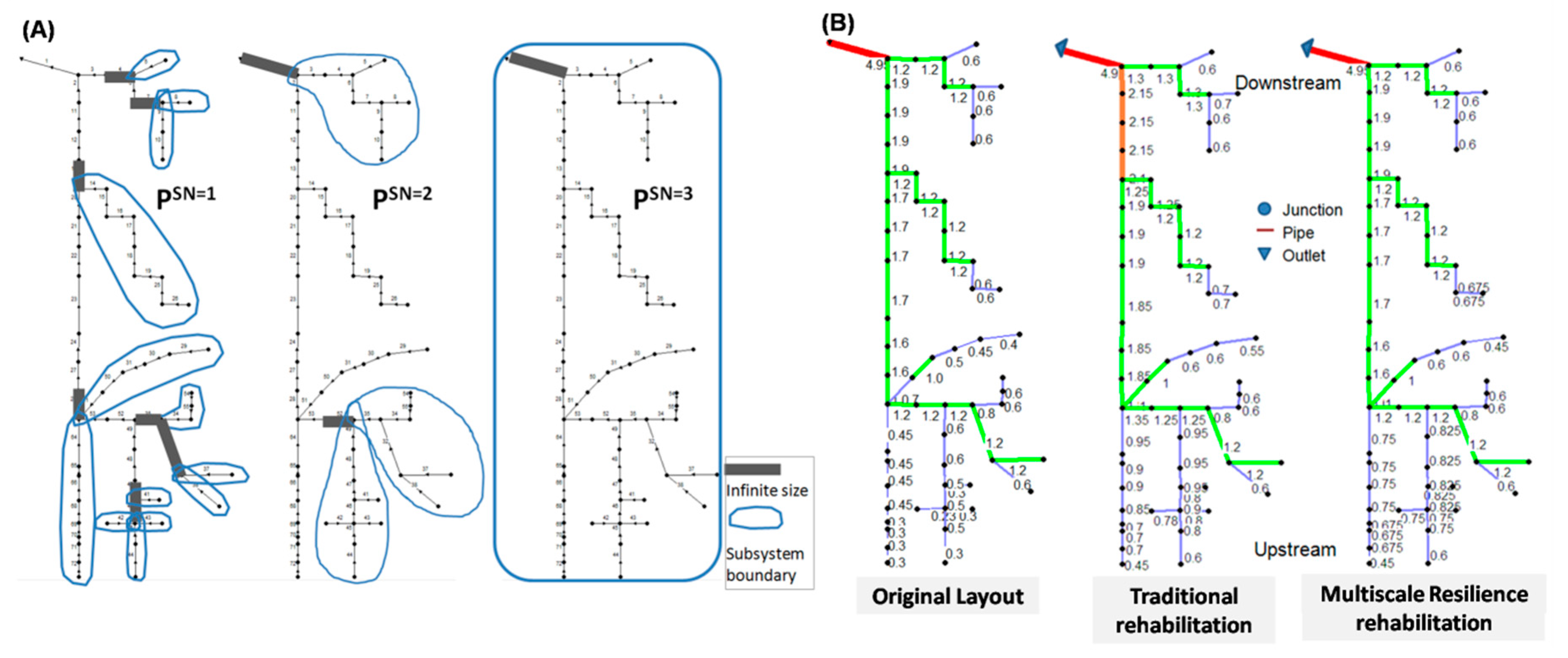

| Size (mm) | Unit Mass (kg/m) | Class 50-D 1 ($/m) | Size (mm) | Unit Mass (kg/m) | Class 50-D 1 ($/m) |
|---|---|---|---|---|---|
| 300 | 225 | 65.9 | 1350 | 1939 | 713.3 |
| 375 | 306 | 81.4 | 1500 | 2123 | 872.4 |
| 450 | 381 | 83.9 | 1650 | 2500 | 1044.70 |
| 525 | 470 | 91.5 | 1800 | 2865 | 1262.40 |
| 600 | 578 | 131.5 | 1950 | 3324 | 1464.10 |
| 675 | 691 | 201.6 | 2100 | 3807 | 1680.00 |
| 750 | 780 | 265.7 | 2250 | 4311 | 1909.30 |
| 825 | 912 | 308.3 | 2400 | 4869 | 2234.70 |
| 900 | 1039 | 369.8 | 2550 | 5179 | 2516.90 |
| 975 | 1195 | 405.7 | 2700 | 5752 | 2793.30 |
| 1050 | 1277 | 464.6 | 3000 | 7043 | 3420.60 |
| 1200 | 1561 | 582.3 |
| Pipe ID | Location | Start Node | End Node | Length (m) | Diameter (mm) | Roughness (Hazen-Williams) |
|---|---|---|---|---|---|---|
| Ex1 | Pump station S3 | J415 | J289 | 15 | 304.8 | 120 |
| Ex2 | Pump station S2 | J256 | J300 | 15 | 254 | 120 |
| Ex3 | Pump station S5 | J323 | J309 | 15 | 203.2 | 120 |
| Ex4 | Pump station S4 | J304 | J301 | 15 | 203.2 | 120 |
© 2020 by the author. Licensee MDPI, Basel, Switzerland. This article is an open access article distributed under the terms and conditions of the Creative Commons Attribution (CC BY) license (http://creativecommons.org/licenses/by/4.0/).
Share and Cite
Diao, K. Multiscale Resilience in Water Distribution and Drainage Systems. Water 2020, 12, 1521. https://doi.org/10.3390/w12061521
Diao K. Multiscale Resilience in Water Distribution and Drainage Systems. Water. 2020; 12(6):1521. https://doi.org/10.3390/w12061521
Chicago/Turabian StyleDiao, Kegong. 2020. "Multiscale Resilience in Water Distribution and Drainage Systems" Water 12, no. 6: 1521. https://doi.org/10.3390/w12061521
APA StyleDiao, K. (2020). Multiscale Resilience in Water Distribution and Drainage Systems. Water, 12(6), 1521. https://doi.org/10.3390/w12061521






